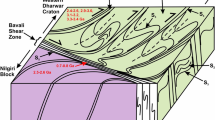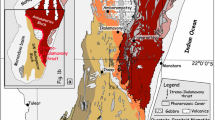Abstract
The Bundelkhand massif, located in the northern part of the Indian shield, is a poly-deformed and poly-metamorphic terrain. This paper reports a new shear system developed throughout the massif in the form of N–S trending quartz veins that are sometimes quartzo-feldspathic and rarely granitic in composition. The veins are vertical and commonly occur in conjugate sets. This tectono-magmatic event appears to represent the youngest shear system of the massif as it cross-cuts all the earlier shear systems (E–W, NE–SE and NW–SE). Emplacement of this N–S vein system may have taken place due to extensional processes that developed some cracks along which siliceous magma was vertically emplaced. The complete absence of signature of the N–S event from the surrounding sedimentary cover of Vindhyan Supergroup, Bijawar and Gwalior Groups suggests that this shear system is pre-tectonic to the nearly E–W trending passive basins developed at the margins of the Bundelkhand craton. Further, several workers have considered the Bundelkhand massif as a part of the Aravalli craton. However, due to the absence of N–S, as well as the other (i.e., E–W, NW–SE and NW–SE), tectonic fabrics of the Bundelkhand massif in other cratons of the Peninsular India, and vice versa, makes the Bundelkhand block a separate and unique craton of its own and is not part of the Aravalli craton.





Similar content being viewed by others
References
Basu A K 1986 Geology of parts of the Bundelkhand granite massif, central India; Rec. Geol. Surv. India Part II 117 61–124.
Basu A K 2007 Role of the Bundelkhand granite massif and the Son–Narmada mega fault in Precambrian crustal evolution and tectonism in central and western India; J. Geol. Soc. India 70 745–770.
Basu A K 2010 Precambrian geology of Bundelkhand terrain, central India and adjacent part of western India; J. Econ. Geol. Georesour. Manag. 7 1–53.
Bhattacharya A R 1985 Some unusual strain relations in elliptically deformed xenoliths and feldspar porphyroblasts; Zeitschr. Geol. Wissen. Berlin 13 689–697.
Bhattacharya A R 1986 Wavelength–amplitude characteristics of polyphase folds in the Precambrian Bundelkhand Complex, India; Tectonophys. 128 121–125.
Bhattacharya A R and Singh S P 2013 Proterozoic crustal scale shearing in the Bundelkhand massif with special reference to quartz reefs; J. Geol. Soc. India 82 474–484.
Chardon D, Jaynanda M, Chetty T R K and Peucat J J 2008 Precambrian continental strain and shear zone patterns: The South Indian case; J. Geophys. Res. 113 B08402, https://doi.org/10.1029/2007JB005299.
Chetty T R K 2010 Structural architecture of the northern composite terrene, Eastern Mobile Belt Indian Implication for Gonwana tecotnics; Gondwana Res. 18 565–582.
Drury S A, Harris N B W, Holt R W, Reevessmith G J and Wightoman R T 1984 Precambrian tectonics and evolution of south India; J. Geol. 92 3–20.
Jolly R J H and Sanderson D J 1995 Variation in the form and distribution of dykes in the Mull swarm, Scotland; J. Struct. Geol. 17 1543–1557.
Jolly R J H and Sanderson D J 1997 A Mohr circle construction for the opening of a pre-existing fracture; J. Struct. Geol. 19 887–892.
Kumar S, Raju S, Pathak M and Pandey A 2010 Magnetic susceptibility mapping of felsic magmatic lithounits in the central part of Bundelkhand Massif, central India; J. Geol. Soc. India 75 539–548.
Kaur P, Armin Z and Chaudhari N 2014 Charecterization of U–Pb–Hf isotopes records of the 3.55 Ga felsic crust from Bundelkhand craton, northern India; Precamb. Res. 255 236–244.
Kaur P, Zehb A, Chaudhri N and Eliyasa N 2016 Unraveling the record of Archaean crustal evolution of the Bundelkhand Craton, northern India using U–Pb zircon-monazite ages, Lu–Hf isotope systematics, and whole-rock geochemistry of granitoids; Precamb. Res., https://dx.doi.org/10.1016/j.precamres.2016.06.005.
Mareschal M, Kellett R L, Kurtz R D, Ludden J N, Ji S and Bailey R C 1995 Archean cratonic roots, mantle shear zones and deep electrical anisotropy; Nature 375 134–137.
Mazumdar R, Van loon A J, Malik A, Reddy S M, Arima M, Altermann W, Eriksson P G and De S 2012 Mesoarchean– Paleoproterozoic stratigraphic records of the Singhbhum crustal province, eastern India: Synthesis; Geol. Soc. London Spec. Publ. 365 39–49.
Mishra D C and Ravi Kumar M 2014 Proterozoic orogenic belts and rift of Indian cratons; Geosci. Frontier 5 25–41.
Mohan M R, Singh S P, Santosh M, Siddiqui M A and Balaram V 2012 TTG suite from the Bundelkhand craton central India: Geochemistry petrogenesis and implications for Archean crustal evolution; J. Asian Earth Sci. 58 38–50.
Mondal M E A, Goswami J N, Deomurari M P and Sharma K K 2002 Ion microprobe 207\(_{{\rm Pb}}\)/206\(_{{\rm Pb}}\) ages of zircons from the Bundelkhand massif, northern India: implications for crustal evolution of the Bundelkhand–Aravalli protocontinent; Precamb. Res. 117 85–100.
Naqvi S M 2005 Geology and Evolution of the Indian Plate; Capital Publishing Company, New Delhi, India, 450p.
Naqvi S M and Rogers J W 1987 Precambrian Geology of India; Monographs on Geology and Geophysics, Oxford University Press, Oxford, 6 p. 223.
Pati J K, Patel S C, Pruseth K L, Malviya V P, Arima M, Raju S, Pati P and Prakash K 2007 Geology and geochemistry of giant quartz veins from the Bundelkhand Craton, central India and their implications; J. Earth Syst. Sci. 116 497–510.
Radhakrishna B P 1989 Suspected tectono-straitigraphic terrane elements in the Indian sub-continent; J. Geol. Soc. India 34 1–24.
Ramsay J G and Huber M I 1987 The Techniques of Modern Structural Geology: Folds and Fractures; Academic Press, London.
Rao J M, Poornachandra G V S, Widdowson M and Kelley S P 2005 Evolution of Proterozoic mafic dyke swarms of the Bundelkhand Granite Massif, Central India; Curr. Sci. 88 502–506.
Ray L, Nagaraju P, Singh S P, Ravi G and Roy S 2016 Radioelemental, petrological and geochemical characterization of the Bundelkhand craton, central India: Implication in the Archean geodynamic evolution; Int. J. Earth Sci. 105 1087–1107.
Roday P P, Diwan P and Singh S 1995 A kinematics model of emplacement of quartz reef and subsequence deformation pattern in the central Indian Bundelkhand batholith; Proc. Indian Acad. Sci. (Earth Planet. Sci.) 104 465–488.
Roy A and Prasad H M 2003 Tectonothermal events in Central Indian Tectonic Zone (CITZ) and its implications in Rodinia crustal assembly; J. Asian Earth Sci. 22 115–129.
Roy A B 2001 Precambrian crustal growth: From the earliest transient crust to the assembly and breakup of supercontinent; Proc. Indian Nat. Sci. Acad. 67 438–460.
Roy A B and Jakhar S Y 2002 Geology of Rajasthan (NW India): Precambrian to Recent; Scientific Publisher (India), 421p.
Santosh M 2011 India’s Paleoproterozoic legacy; Geol. Soc. London Spec. Publ. 365 263–288.
Sarkar A, Paul D K and Potts P J 1996 Geochronology and geochemistry of the Mid-Archaean trondhjemitic gneisses from the Bundelkhand craton, central India; In: Recent Researches in Geology (ed.) Saha A K, 16 76–92.
Sharma K K 2000 Evolution of Archean Plaleoproterozoic crust of the Bundelkhand craton, northern Indian shield; In: Research Highlights in Earth System Science (eds) Verma O and Mahadevan T M, DST Special Publication No. 1, Pg. Ind. Geological Congress, pp. 95–105.
Sharma R S 2009 Cratons and Folded Belts of India; Springer Publication, 319p.
Singh S P and Bhattacharya A R 2010 Signatures of Archaean E–W crustal-scale shears in the Bundelkhand Massif, central India: An example of vertical ductile shearing; Earth Sci. India 3 217–225.
Singh S P 2012 Archean geology of Bundelkhand craton, central India: An overview; Gondwana Geol. Mag. 13 125–140.
Singh S P and Dwivedi S B 2015 High grade metamorphism in the Bundelkhand Massif and its implications on Mesoarchean crustal evolution in central India; J. Earth Syst. Sci. 124 197–211.
Singh S P, Singh M M, Srivastava G S and Basu A K 2007 Crustal evolution in Bundelkhand area, central India; Him. Geol. 28 79–101.
Speight J, Skelhorn R, Sloan T and Knaap R 1982 The dyke swarms of Scotland; In: Igneous rocks of the British Isles (ed.) Sutherland D S, John Wiley and Sons, Chichester, pp. 449–459.
Acknowledgements
ARB thanks the Head, Centre of Advanced Study in Geology, University of Lucknow, for providing working facilities. We would also like to thank the two anonymous reviewers of this paper for their constructive comments and suggestions. Finally, thanks to Dr A K Verma for his help during preparation of the manuscript.
Author information
Authors and Affiliations
Corresponding author
Additional information
Corresponding editor: Saibal Gupta
Rights and permissions
About this article
Cite this article
Singh, S.P., Bhattacharya, A.R. N–S crustal shear system in the Bundelkhand massif: A unique crustal evolution signature in the northern Indian peninsula. J Earth Syst Sci 126, 121 (2017). https://doi.org/10.1007/s12040-017-0900-5
Received:
Revised:
Accepted:
Published:
DOI: https://doi.org/10.1007/s12040-017-0900-5




